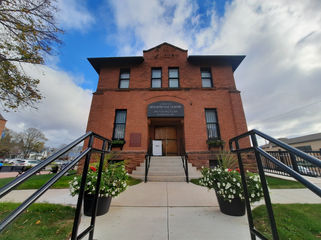Summerside Interpretive Centre

33 Summer Street,
Summerside, PE
Off-season (October - June):Book your appointment by calling902-432-1332 or 902-432-1298
Summer:
10 am to 5 pm
Monday to Saturday
June 24 to August 31
September: Tuesdays and Thursdays
10 am to 4 pm
Off-season (October - June):
Admission by donation.
The Summerside Interpretative Centre is located in the refurbished 1911 Armoury. Through a digital self-guided tour, visitors can view six different exhibits about the people, places, and stories of Summerside and Prince Edward Island. In the beautiful historic surroundings, the visitor can relax and through modern technology, chose the depth of exhibit information they wish to explore. As each exhibit stands on its own, the visitor is free to concentrate on what interests them on a given visit. Exhibits change on a rotational basis. The PEI Fox Museum is also located on-site.
The Summerside Interpretative Centre is about celebrating the rich heritage and personality of the place we call home.
The Summerside Armoury holds a prominent place in the history of Prince County. It was built in 1911, for the local Militia, who had lost their Drill Shed to fire. During both world wars it served as the main recruiting centre for Prince County, and headquarters of the strong Homefront effort. During eight-one years of occupancy, the Militia kindly shared the Armoury with community groups. Upon removal of the Militia in 1992 to larger quarters, the Armoury, one of the remaining few of its design, became a city property. As of 2005 it became home of the International Fox Museum. The Armoury went under a series of renovations and in the summer of 2022 opened as the new Summerside Interpretive Centre.

History of the 1911
Summerside Armoury
005.13 Gerard and Florence Gallant Collection
The necessity for an Armoury in Summerside arose after the Drill Shed on Spring Street burned to the ground in the Great Fire of 1906. In 1908 the Dominion government purchased land for a new building to be located south of the Post Office, now part of City Hall, on Summer Street. The contract was awarded in October 1910 to M. F. Schurman & Company but excavation for the 38 x 34 foot cellar did not begin until June 1911. The two-storey structure was completed by the following summer and the formal transfer from the Department of Public Works to the 82nd Regiment took place June 22, 1912.
Members of the No. 3 Company of the 82nd Regiment (Abegweit Light Infantry) held their first annual drill in the Summerside Armoury in May 1913. The following year B Squadron of the PEI Light Horse was organized. Many of the local militia members enlisted in the Canadian Expeditionary Force at the beginning of the First World War. In the early months of 1916 new recruits used the grounds, known as Armoury Square, for regular drilling. The men constructed trenches complete with dugouts and loopholes and used dummies to practice bayonet fighting.
In the early 1920s the Armoury Square was the convenient location for Chautauqua, the adult education movement that spread across North America in that decade. Its purpose was to bring entertainment and culture to communities through presentations by prominent speakers, musicians, preachers and entertainers of the day.
After the war, veterans established a Great War Veterans Association (GWVA) clubroom in the Armoury and continued to use the facility after obtaining a branch charter for the Royal Canadian Legion in 1931. During the 1930s C Company of the PEI Highlanders, which had replaced the 82nd Regiment in 1922, kept uniforms and equipment in the building and held drills in the local curling rink.
The Armoury was used on a regular basis for army recruitment during World War II. It was also the headquarters of B Squadron of the 17th (Reserve) Armoured Regiment. By 1946 the federal government admitted that the facility was “old and out of date.” However, the structure continued to be used by the local squadron of the PEI Regiment until June 1992 when the forty members of B Squadron began to operate out of a building in Slemon Park, the former Canadian Forces Base Summerside.
Public Works Canada, acting on behalf of the Department of National Defence, sold the structure to the City of Summerside in 1996. The municipal recreation department had offices in the building until the new City Hall was opened in 2003. The Armoury remained in the City’s ownership and housed the International Fox Museum and Hall of Fame.
In 2011, to celebrate the 100th anniversary of the building, a series of vignettes were produced to record the significance of the Armoury to the community of Summerside. Also in that year a didactic panel reviewing the history of the century-old heritage structure was installed on the lawn. A new chapter in the history of the Armoury has opened, now serving the community as the Summerside Interpretive Centre.











